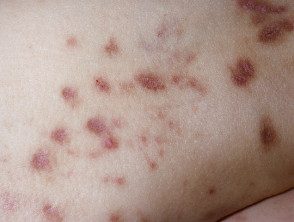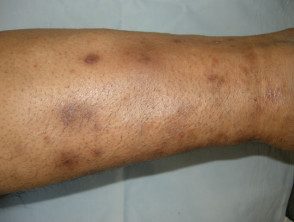Introduction
It is estimated that 30% of patients with diabetes mellitus will experience a skin problem at some point during the course of their disease. Various skin disorders are more common in diabetic patients, particularly those due to infection like candida and impetigo. Type 2 diabetes patients also have twice the risk of developing the common disease. scaly disease, psoriasis, such as non-diabetic.
Skin conditions associated with diabetes mellitus.

Impetigo

Candida intertrigo

Psoriasis
Specific skin conditions associated with diabetes mellitus are described below.
- Diabetic dermopathy
- Diabetic bullas
- Diabetic stiff skin
- Others
What is diabetes mellitus?
Diabetes mellitus is a collection of various disorders associated with increased blood. glucose concentration.
Diabetes is associated with impaired carbohydrates, proteins, and fats. metabolism due to insufficient secretion of insulin or insulin resistance of the target tissue. Complications of diabetes mellitus include macrovascular (cardiovascular) and microvascular (retinopathy, nephropathy, or neuropathy) aftermath.
Type 1 diabetes mellitus is characterized by an absolute absence of insulin and is due to autoimmune Destruction of beta cells. It is usually presented with acute symptoms or ketoacidosis in childhood or adolescence, and lifelong insulin therapy is mandatory.
Type 2 diabetes mellitus is a common disorder classified by insulin resistance and relative insulin deficiency. Patients are often asymptomatic and they are diagnosed through screening. Strong risk factors include older age, obesity, physical inactivity, prior gestational diabetes, prediabetes, non-white ancestry, a family history of diabetes, and a polycystic ovary. syndrome. Modification of cardiovascular risk factors (eg, hypertension and dyslipidemia) are an important part of treatment, along with blood glucose control to prevent microvascular complications.
Type 2 diabetes is the leading cause of type 2 diabetes in children, who are generally older than 10 years. Acanthosis nigricans accompanies childhood diabetes at 90 to 95%.
Gestational diabetes is diagnosed if glucose intolerance is first recognized during pregnancy at 24–28 weeks' gestation. Strong risk factors include advanced maternal age (over 40 years), obesity, a personal history of gestational diabetes or macrosomia affecting a previous child, polycystic ovary syndrome, non-white ancestry, and a family history of diabetes mellitus.
Other presentations of diabetes mellitus include diabetic ketoacidosis, hyperosmolar hyperglycemic state, diabetic cardiovascular disease, diabetic kidney disease, diabetic neuropathy, diabetic foot, diabetic retinopathy, and metabolic syndrome.
Increasing predominance of diabetes requires screening to detect diabetes and prediabetes in risk groups to prevent and mitigate disease progression.
Diabetic dermopathy
Diabetic dermopathy is a skin condition characterized by scaly patches that are light brown or reddish, oval or round, slightly bleeding that appear most often on pimples. Although these injuries can appear in anyone, particularly after an injury or trauma in the area, they are one of the most common skin problems found in patients with diabetes mellitus. Diabetic dermopathy has been found to occur in up to 30% of patients with diabetes.
Diabetic dermopathy is also sometimes known as pimples and pigmented pretibial patches look like solar energy lentigines.
Diabetic dermopathy

Diabetic dermopathy

Diabetic dermopathy

Diabetic dermopathy
What Causes Diabetic Dermopathy?
The exact cause of diabetic dermopathy is unknown, but it may be associated with diabetes. neuropathic and vascular complications, as studies have shown that the condition occurs more frequently in diabetic patients with retinopathy, neuropathy, and kidney disease.
Diabetic dermopathy tends to occur in older patients or in those who have had diabetes for at least 10-20 years. It also appears to be closely related to increased glycosylation hemoglobin, an indicator of poor control of blood glucose levels.
Because injuries often occur in bony parts of the body, such as shins, it is believed that diabetic dermopathy may also be a magnified response to injury or trauma to these areas. Studies have shown that pimple spots have appeared in response to trauma with heat, cold, or blunt objects in patients with diabetes.
What are the signs and symptoms?
Diabetic dermopathy lesions most often appear on the shins. Less commonly, lesions can be found on the front of the thighs, forearm, side of the foot, scalp, and trunk. The characteristics of the lesions are:
- Round or oval
- Reddish brown color
- Initially flaky, but then flattens and bleeds
- They commonly occur on both pimples.
The presence of four or more lesions is almost always limited to patients with diabetes. People with pimple spots who have not yet been diagnosed with diabetes should undergo further investigation to rule out the possibility of early diabetes.
What is the treatment for diabetic dermopathy?
Diabetic dermopathy lesions or pimples are harmless. They generally don't require any treatment and tend to go away after a few years, particularly after better blood glucose control.
Diabetic bullae
Diabetic blisters, also known as diabetic bullosis, are blister-like lesions that occur spontaneously on the feet and hands of diabetic patients. Although rare, diabetic blisters are a hallmark marker of diabetes.
- Diabetic blisters are more common in men than women.
- Are predominant between the ages of 17 and 84.
- They are also more common in patients who have long-standing diabetes or multiple diabetic complications, particularly neuropathy.
The blisters are painless and can be 0.5 to 17 centimeters in size. They are often irregular in shape. Two types of diabetic blisters have been defined.
- Intraepidermal blisters: these are clear, sterile filled blisters viscous fluid and normally heals spontaneously within 2 to 5 weeks without scarring and atrophy.
- Sub-epidermal bullae: these are less common and can fill with blood. Healed blisters may show scarring and atrophy.
In most cases, diabetic blisters heal spontaneously without treatment. Patients should ensure that the blister remains intact to avoid secondary infection.
Diabetic bullae

Diabetic bullae

Diabetic bullae

Diabetic bullae
Diabetic stiff skin
Many patients with long-standing type 1 diabetes develop diabetic keiroarthropathy or diabetic rigid skin (digitalis sclerosis) This results in restricted mobility of your hand joints and stiff, waxy, thickened and yellowish skin. This is believed to be due to the reaction of glucose with proteins in the skin and an increase in glycation end products. These patients may also suffer from Dupuytren contracture (Tension of the tendon, which bends the fingers).
Diabetic stiff skin

Diabetic stiff skin

Diabetic stiff skin

Diabetic stiff skin
Other dermatological conditions associated with diabetes.
Other common conditions in diabetics are foot ulcers and necrobiosis lipoidica
Diabetics with renal Faults are also prone to reactive perforating collagenosis and Kyrle's disease.
-
Scleroedema - a rare complication of type 2 diabetes that causes thickening of the skin on the neck and upper back
- Disseminated granuloma cancel
- Eruptive xanthoma on the hands, arms, feet, legs, and buttocks associated with high levels of cholesterol and triglycerides


Generalized granuloma annulare

Eruptive xanthoma
- Xanthelasma: multiple yellowish scaly patches on and around the eyelids
- Skin tags
-
Vitiligo - an autoimmune skin problem sometimes associated with type 1 diabetes

Xanthelasma

Skin tag

Vitiligo
-
Acanthosis nigricans: darkening and thickening of the skin folds, which is believed to be due to insulin resistance.
-
Lipoid necrobiosis - yellow, waxy plates on the shin
- Pruritus - This can have many causes, such as fungal infection, dry skin, neuropathy, or poor blood flow.
- Cutaneous dysesthesia - due to small fiber neuropathy

Acanthosis nigricans

Lipoid necrobiosis

Itching excoriations
- Bacterial skin infections, including stye, boil, abscess, paronychiacellulitis
-
Fungal infections, particularly Candida albicans

Boil

Cellulitis

Candida intertrigo
